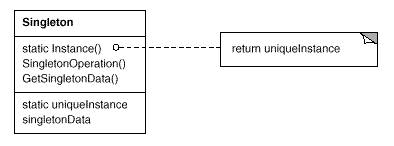Singleton:Ensure a class only has one instance, and provide a global point of access to it.
一个类只能有一个实例的创建模式。
一:引入
在某些情况下一个类只能有一个实例,如果多于一个实例就会导致逻辑错误。
- 非共享资源:如打印机,系统属性文件
- 其他:如数据库主键生成器,只能有一个地方分配,否则会出现重复主键
- EagerSingleton(饿汉式单例):

 /** */
/**
/** */
/** * 饿汉式单例
* 饿汉式单例 */
*/

 public
class
EagerSingleton
...
{
public
class
EagerSingleton
...
{ //类加载时实例化
//类加载时实例化 private static final EagerSingleton instance=new EagerSingleton();
private static final EagerSingleton instance=new EagerSingleton(); //构造函数设为私有,不能以new的方式生成新的实例
//构造函数设为私有,不能以new的方式生成新的实例 private EagerSingleton()
private EagerSingleton()
 ...{
...{  }
} //提供给客户的得到唯一实例的方法
//提供给客户的得到唯一实例的方法 public static EagerSingleton getInstance()
public static EagerSingleton getInstance()
 ...{
...{ return instance;
return instance; }
} }
}

 public
class
Client
...
{
public
class
Client
...
{ public static void main(String args[])
public static void main(String args[])
 ...{
...{ EagerSingleton s1 = EagerSingleton.getInstance();
EagerSingleton s1 = EagerSingleton.getInstance(); EagerSingleton s2 = EagerSingleton.getInstance();
EagerSingleton s2 = EagerSingleton.getInstance();
 if( s1 == s2 )
if( s1 == s2 ) System.out.println( "s1 == s2" );
System.out.println( "s1 == s2" ); }
} }
}
问题:
- 类在加载时就将自己实例化,对于象资源控制器之类的类初始化可能耗费很多时间。还可能会导致出现多线程首次同时引用子类的几率变得比较大。
- 构造函数为私有,不能被继承。
- LazySingleton(懒汉式单例)--延迟加载(访问时加载)

 /** */
/**
/** */
/** * 懒汉式单例
* 懒汉式单例 */
*/

 public
class
LazySingleton
...
{
public
class
LazySingleton
...
{ //类加载时为null,不实例化
//类加载时为null,不实例化 private static LazySingleton instance=null;
private static LazySingleton instance=null; //构造函数设为私有,不能以new的方式生成新的实例
//构造函数设为私有,不能以new的方式生成新的实例 private LazySingleton()
private LazySingleton()
 ...{
...{  }
} //提供给客户的得到唯一实例的方法
//提供给客户的得到唯一实例的方法 public static LazySingleton getInstance()
public static LazySingleton getInstance()
 ...{
...{ //如果没有创建实例就创建,否则就用以前创建了的那个。
//如果没有创建实例就创建,否则就用以前创建了的那个。 if (instance==null) instance=new LazySingleton();
if (instance==null) instance=new LazySingleton(); return instance;
return instance; }
} }
}
- 第一次访问时实例化,资源利用效率比饿汉式要好,但第一次访问时反应时间不如饿汉式。
- 因为构造函数私有,也不能被继承。
上例没有考虑到多线程环境,如果第一个线程执行到 if(instance==null)且还没有执行instance=new LazySingleton()时,另一个线程也执行到 if(instance==null)这时条件也为true,所以也会执行new LazySingleton()导致多实例。
 //
整个方法都加锁,防止多线程环境下的问题
//
整个方法都加锁,防止多线程环境下的问题
 synchronized
public
static
LazySingleton getInstance()
synchronized
public
static
LazySingleton getInstance()
 ...
{
...
{ //如果没有创建实例就创建,否则就用以前创建了的那个。
//如果没有创建实例就创建,否则就用以前创建了的那个。 if (instance==null) instance=new LazySingleton();
if (instance==null) instance=new LazySingleton(); return instance;
return instance; }
}

 /** */
/**
/** */
/** * 懒汉式单例,多线程环境
* 懒汉式单例,多线程环境 */
*/

 public
class
LazySingleton
...
{
public
class
LazySingleton
...
{ // 类加载时为null,不实例化.
// 类加载时为null,不实例化. // volatile ensures that multiple threads handle the instance variable
// volatile ensures that multiple threads handle the instance variable // correctly
// correctly // when it is being initialized to the Singleton instance.
// when it is being initialized to the Singleton instance. private volatile static LazySingleton instance = null;
private volatile static LazySingleton instance = null;
 // 构造函数设为私有,不能以new的方式生成新的实例
// 构造函数设为私有,不能以new的方式生成新的实例
 private LazySingleton() ...{
private LazySingleton() ...{ }
}
 // 两阶段加锁,防止多线程环境下的问题,效率比整个方法加锁高。
// 两阶段加锁,防止多线程环境下的问题,效率比整个方法加锁高。
 public static LazySingleton getInstance() ...{
public static LazySingleton getInstance() ...{ // 如果没有创建实例就创建,否则就用以前创建了的那个。
// 如果没有创建实例就创建,否则就用以前创建了的那个。
 if (instance == null) ...{
if (instance == null) ...{
 synchronized (LazySingleton.class) ...{
synchronized (LazySingleton.class) ...{
 if (instance == null) ...{
if (instance == null) ...{ instance = new LazySingleton();
instance = new LazySingleton(); }
} }
} }
} return instance;
return instance; }
} }
}
二:结构

三:实际应用
- java.lang.Runtime

 public
class
Runtime
...
{
public
class
Runtime
...
{ private static Runtime currentRuntime = new Runtime();
private static Runtime currentRuntime = new Runtime();

 /** *//**
/** *//** * Returns the runtime object associated with the current Java application.
* Returns the runtime object associated with the current Java application. * Most of the methods of class <code>Runtime</code> are instance
* Most of the methods of class <code>Runtime</code> are instance  * methods and must be invoked with respect to the current runtime object.
* methods and must be invoked with respect to the current runtime object.  *
*  * @return the <code>Runtime</code> object associated with the current
* @return the <code>Runtime</code> object associated with the current * Java application.
* Java application. */
*/
 public static Runtime getRuntime() ...{
public static Runtime getRuntime() ...{  return currentRuntime;
return currentRuntime; }
}

 /** *//** Don't let anyone else instantiate this class */
/** *//** Don't let anyone else instantiate this class */
 private Runtime() ...{}
private Runtime() ...{} }
}
四:适用情形
Use the Singleton pattern when
there must be exactly one instance of a class, and it must be accessible to clients from a well-known access point.when the sole instance should be extensible by subclassing, and clients should be able to use an extended instance without modifying
参考文献:
1:阎宏,《Java与模式》,电子工业出版社
2:Eric Freeman & Elisabeth Freeman,《Head First Design Pattern》,O'REILLY




















 101
101

 被折叠的 条评论
为什么被折叠?
被折叠的 条评论
为什么被折叠?








